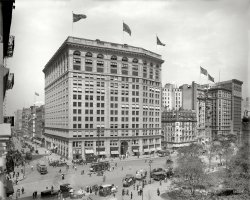
MAY CONTAIN NUTS

Search Shorpy
SHORPY ART

Framed or unframed, desk size to sofa size, printed by us in Arizona and Alabama since 2007. Explore now.
Join and Share
Ad-Free Shorpy
Shorpy is funded by you. Patreon contributors get an ad-free experience.
Learn more.

Recent comments
- Robie House Roof(s)
- There is an interesting novel set here.
- I Was In Berlin
- Pronunciation
- Shell of a Shell
- Never been there but
- BUR-lin
- Hand-made smokes
- Birthplace of Tupperware, or at least its inventor
- Pulp
- Remarkably unchanged in 84 years
- The church is still there ...
- Talk about a smoke show
- Electric Hansom Cab
- I wondered the same thing.
- The location in 2009
- Pill Pusher
- Roll your own
- Rugged and real!
- Civil War history
- Early EV?
- A Charles Purcell - Mama Cass Connection
- Uncle SAAM
- Obfuscation
- One Chocolate Soldier rode away
- Victor Marquis de la Roche
- The Little House Across Way ...
- Vanderbilt Gates
- Vanderbilt Mansion
- You can still see that gate
Member Photos
The Shorpy
Printporium
Printporium
Search Shorpy
Search results -- 30 results per page
- Yosemite Cadillac: 1919
- ... touring car at Yosemite in snow." With the Sentinel Hotel in the background. 6½x8½ inch glass negative. View full size.
Sentinel Hotel "Near view of the three-story Sentinel Hotel, early 1920s, Yosemite ... Posted by Dave - 06/09/2015 - 6:13pm -
![Yosemite Cadillac: 1919 The high Sierras circa 1919. "Cadillac touring car at Yosemite in snow." With the Sentinel Hotel in the background. 6½x8½ inch glass negative. View full size.
Sentinel Hotel"Near view of the three-story Sentinel Hotel, early 1920s, Yosemite Valley; with three autos parked along street, and valley cliffs in distance." From the San Joaquin Valley & Sierra Foothills Photo Heritage.
Artist Beautiful photograph. The talent of the photographer comes through and makes me all that more envious of what was accomplished when considering the materials and processes that they worked with back in the day.
[Those "materials and processes" are why the photo turned out so well. Giant glass negatives make better pictures than smaller-format film. - Dave]
Medium- and large-format negsChurchkey, in the mid-to-late 1960s, we couldn't use 35mm as it wasn't considered, at least by the folks who ran the newspaper I worked on, as a professional format.
I didn't care, as I loved my medium-format twin-lens relex Rolleis and Mamiya cameras. Plus, especially with large-format film like in the Speed Graphics, shooting ball games was much easier than with a 35mm. As long as you pointed in the right direction and tripped the shutter at the right time, the action was somewhere on that big neg. You just cropped tight and were a hero.
(The Gallery, Cars, Trucks, Buses, W. Stanley)](https://www.shorpy.com/files/images/SHORPY-337-01A.thumbnail.jpg)
- Balcony View: 1923
- ... a street name has its business on that same street.
Hotel Monteleone Maybe Royal between Bienville and Iberville, facing SW toward Canal Street? Somewhere around the Hotel Monteleone.
500 block of Royal Street About halfway between ... Posted by Dave - 03/10/2014 - 11:23pm -
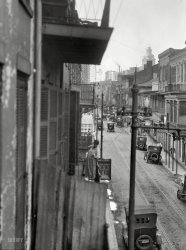
- Night in the Big Easy: 1941
- ... all of the revelers are off the street. Some to the Jung Hotel, perhaps, now closed (owned by a successor hotel chain) since Katrina. Photo taken by the father of one of my best ... Posted by Don Struke - 09/13/2010 - 10:26am -

- Open All Year: 1901
- Circa 1901. "Hotel Islesworth, Atlantic City, N.J." 8x10 inch dry plate glass negative, ... buried beneath the Trump Taj Mahal.
Postcard of the Hotel Here is a postcard of the Hotel circa 1910's
(The Gallery, Atlantic City, DPC) ... Posted by Dave - 04/07/2015 - 9:06am -
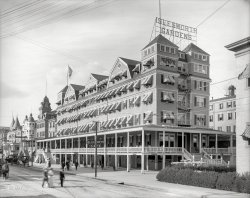
- Satyricon: 1925
- ... Post, Aug 3, 1921
Shades of the Overlook Hotel Oh boy. Didn't I see this scene in Kubrick's "The Shining?"
... Posted by Dave - 08/27/2012 - 3:42pm -
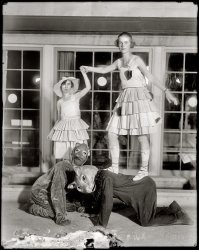
- Boardwalk Empire: 1910
- Atlantic City, N.J., circa 1910. "Boardwalk, Hotel Marlborough-Blenheim and Young's Million-Dollar Pier." There are a ... two tall pillars or columns, might serve on the central hotel with the dome and all the gingerbread? They seem strange and lonely. ... Posted by Dave - 07/20/2012 - 3:36pm -
![Boardwalk Empire: 1910 Atlantic City, N.J., circa 1910. "Boardwalk, Hotel Marlborough-Blenheim and Young's Million-Dollar Pier." There are a zillion interesting details in this panorama made from four 8x10 inch glass negatives. View full size.
Just imagineTo be able to take for granted that you will walk outside to such beautiful buildings, a boardwalk where everyone is nicely dressed and you can even walk six abreast, sweeping lawns, spacious streets, peaceful porches to rock on, an almost empty beach to sit on. They probably took much of it for granted and certainly didn't know how amazing and wonderful it would look to me 100 years hence.
A Monumental ChallengeDo any of our talented colorizers dare tackle such a sweeping scene?
Are any of these buildings still standing?Maybe someone familiar with Atlantic City knows. I've never been there.
AmazingThe scope of the shot is breathtaking! From the chimney that needs repair in the lower right corner and the "hidden" clotheslines on that roof, to the confection of the M-B to the Pier and the vistas beyond and the wonderfully random set of tracks throught the sand. These people wouldn't recognize Atlantic City today.
Such detail. All in focus.This is a fantastic photo. You might even say it took my breath away. Nice to see an old shot like this and have everything look so new and clean. I'm amazed to see so much built in 1910. I'm going to have to do some research and discover the Atlantic City timeline. I was always under the impression it lagged behind Coney Island, but here it looks as though they were in place about the same time.
Amazing DetailThis is just a fabulous image. It's fascinating to study the various hotels (I assume), porches, rooflines plus the people on the boardwalk and beach. It just goes on and on.
Mary PoppinsApart from the cigarette ad, it could be a Disney film set. Wonderful photo.
Photography and condimentsNice view of another set of tripod legs and camera just below the apparent center view point of this pan. And just to the bottom right a wood headed greenhouse with the little cart of wood right beside the wood heater. Windows of the spice/condiment bays stored neatly behind the hedge in back of the green house. You can almost imagine the year long work of someone to make sure this operation always provides fresh things for the chef.
Steve BuscemiAnyone who's watched "Boardwalk Empire" has to believe many of these photos must have been used to create the CGI backgrounds they use for various shots.
[The "Boardwalk Empire" production company is one of our print customers. -Dave]
A Lot of GasI see at least four gasometers (gas holders) in the photo.
The Twin TowersDoes anyone know what purpose two tall pillars or columns, might serve on the central hotel with the dome and all the gingerbread? They seem strange and lonely. Couldn't be elevator works inside, or ... what?
[Chimneys. - Dave]
Coney & ACConey Island became what it is because of the availability of public transportation. The first subway line or El trains were built in the late 1800s. This afforded relatively cheap rides to the beach. There were hotels but nothing like those in Atlantic City. Although it was a reasonable distance from Philadelphia and NY it still required the railroads to move the more distant customers to the Jersey Shore. I'm sure there were day trippers but many people came to spend their vacations in the luxury of the the hotels.
Park PlaceThe park in the front of the photo is Brighton Park. The street between the park and the hotel is Park Place.
The Marlborough-Blenheim remained in great condition through the seventies. In 1979, Bally's bought it and replaced it with the Bally's Park Place Casino.
Make Room for Bally'sThe Marlboro-Blenheim started construction in 1902 and completed in 1906. In 1978 it was demolished to make way for Bally's Park Place casino. Bally's Wild West Casino now sits where that little park looking thing is and Young's Million Dollar Pier became The Pier Shops at Caesar's in 2006.
Wheelchair RampThe hotel at the end of the great lawn had a wheelchair ramp installed after the building was constructed. You can see how it sits on top of the original staircase. I wonder what VIP stayed there to justify building that?
[The ramps were for "rolling chairs." Not quite the same as wheelchairs. - Dave]
Obviously shot from the Traymore HotelJust as this 1910 postcard picture was obviously shot from the "wedding cake" part of the Marlborough-Blenheim. Some of the same things are visible from the opposite side such as the Y-shaped walkway in the garden-like area and even the greenhouse.
Beautiful BuildingsI wish Atlantic City looked like this today. These are gorgeous buildings, unlike the ugly buildings that one sees there now. It must have been a great place to vacation in those days.
"Boardwalk Empire" BoardwalkThe set is located at Newtown Creek and the East River, Brooklyn side in NYC. It is surrounded with cargo containers stacked four high hung with blue screen so the background can be matted in electronically. Some blue screen can be seen at the left of the photo on a stack of containers.
Google Earth: Dupont and Franklin St., Greenpoint, Brooklyn, NY
(Panoramas, Atlantic City, DPC, Swimming, Travel & Vacation)](https://www.shorpy.com/files/images/SHORPY_Atlantic_City_panorama.thumbnail.jpg)
- Rest Stop: 1905
- ... to utter the phrase "Don't make me stop the car!"
Hotel burned in 1930 A scenic overlook (a rest stop!) was built on the location where the hotel once stood, and is located along Route 611.
View Larger Map ... Posted by Dave - 07/28/2014 - 1:21pm -
![Rest Stop: 1905 Circa 1905. "Front piazza of Kittatinny House, Delaware Water Gap, Pennsylvania." An up-to-date inn catering to the automobilist with such amenities as cafe and public telephone. 8x10 inch glass negative. View full size.
Lost to HistoryThe name of the first parent to utter the phrase "Don't make me stop the car!"
Hotel burned in 1930A scenic overlook (a rest stop!) was built on the location where the hotel once stood, and is located along Route 611.
View Larger Map
A little backgroundFrom the Pocono Record; click here.
Who knew?Never knew we had a piazza - we called it the porch.
Wouldn't you rather have a Winton?At least, with the scroll on the body, the odd fender/running board, and handy basket, that's what it looks like to me. Photo is a 1904 model.
Note the neatly matching license plate(?) and numbered running light lenses. Also note what looks like a giant windshield frame but is probably just a support for the canopy. There doesn't seem to be any glass in it.
License plateNice shot of what is known as a "pre-state" plate, i.e., one produced before states began issuing plates. These plates would be made by the car owner, often using a kit supplied for the purpose [similar plates existed for horse and buggy use earlier], and the plate number would be registered with the local authorities.
Most northeastern states such as Pennsylvania had state-issued plates by 1910, but the pre-state plates continued to be used through the 1910s [for instance, our first state-issued plates here in Texas didn't come out until 1917]. Many Texas pre-state plates even had the name of the town or city in addition to the registration number.
Ain't Fair!Dad gets to wear that spiffy coat and hat with neat engineer gloves and I have to dress like a reject from Miss Priscilla's Paisley Perambulators.
(The Gallery, Cars, Trucks, Buses, DPC)](https://www.shorpy.com/files/images/SHORPY-4a22029a.thumbnail.jpg)
- Broadway Blizzard: 1905
- ... https://daytoninmanhattan.blogspot.com/2010/07/1868-grand-hotel-broadway...
Times Tower in the Distance In the far distance, ... artificially. The implications are frightening.
Grand Hotel is Still There The Grand Hotel is located at 1232–1238 Broadway at ... Posted by Dave - 01/11/2022 - 12:18pm -
![Broadway Blizzard: 1905 New York, 1905. "Piles of snow on Broadway after storm." Funny-sign photobomb! 8x10 inch dry plate glass negative, Detroit Publishing Company. View full size.
Sol Young PhotographyInteresting business and family history.
http://photo-sleuth.blogspot.com/2009/10/musing-in-manhattan.html
Or reading the marquee at Wallack's TheaterThe man at far left is walking on an icy sidewalk while craning his head around to look behind him. My guess is he is admiring the receding woman in the heavy coat.
This is Broadway between 29th and 30th Streets, looking north. Brickwork detail on the three-story building, painted white at right confirms this is the Maurice Rogaliner building in the 1905 photograph. Most everything else has changed. Everything on the immediate left is definitely gone; a glass and steel skyscraper is going up in its place.
A Sign Planted in a Heap of Irony"Earlaps" on a straw boater -- now that's something I'd like to see.
Sarnoff signWhy would you photo-shop the Sarnoff sign in the picture?
[Seriously? - Dave]
Blow the picture up, and look at the focus compared to the rest of the picture, look at the edges of the sign. I'm not saying you photo shopped it, but somebody did.
[Um, no. Click the link below. - Dave]
https://www.loc.gov/pictures/item/2016794896/
Well, the evidence certainly supports you. Maybe the current state of the world just makes me overly suspicious ...
On Broadway steht ein HofbräuhausEins, zwei, g'suffa!
Great Winter Photo!Makes me want to wear a straw hat as I take a stroll through a pile of cold, wet, snow. The man, on the right, driving the horse drawn "cab" is looking at the photographer as he wears a black top hat.
Thanks for posting this neat photograph!
Hofbrau StarI am captivated by the Hofbrau Haus building with its prominent Star of David on the facade. Would love to know more.
Disunswelterized strawThe social standards that led to the Straw Hat Riot seventeen years thence apparently did not exist in 1905. No need for "earlaps" (if they are what I think they are) when your boater is not going to survive past September 15. Hopefully, the attachments were connected by a nice, warm felt or knit beanie to do the job properly.
Or you could invest in a Stormy Kromer for winter wear. They've been around since 1903, but were/are likely far too stylish for the average New Yorker.
Old even then!Agree with Doug on Maurice Rogaliner. The left side of the street was probably replaced within a decade or two of the photo; 2009 Street View shows all blocky 1920s piles. But there's one other recognizable building in the photo that's still standing -- and it was already pushing 40 in 1905!
https://daytoninmanhattan.blogspot.com/2010/07/1868-grand-hotel-broadway...
Times Tower in the DistanceIn the far distance, seemingly standing in the middle of Broadway, is the just completed Times Tower, on the far side of 42nd Street. This Gothic Revival skyscraper was designed by C. L. W. Eidlitz and Andrew McKenzie and built in 1903-1905. When the New York Times moved into its new home, the name of the square behind it was changed from Longacre Square to Times Square. The Times Tower is still standing today but completely unrecognizable. It is best known as the place where the ball drops at midnight on New Year's Eve.
DeepfakeI'm assuming that Dave simply doesn't want to spend his time taking the bait, but I'll comment on the putatively photoshopped sign because it segues into a bigger issue that I find very interesting.
In this case, one can simply look at the LOC high resolution original to see that the sign has not been photoshopped by anyone. Of course, the LOC could have faked it, but then we could just look at the glass negative to disprove that conspiracy theory.
Anyhow, the bigger issue is what will occur in the future (hopefully not in my lifetime) where a faked image or video will be absolutely indistinguishable from a real one, and any controversy such as the one regarding this hat sign will only be solved by a preponderance of opinion. It is already theoretically possible, since digital imagery is made of pixels dictated by binary code, and there is no difference between ones and zeros that are created "naturally" or artificially. The implications are frightening.
Grand Hotel is Still ThereThe Grand Hotel is located at 1232–1238 Broadway at the corner of West 31st Street. It was added to the National Register of Historic Places in 1983.
Hats for sale?Has anyone noticed that the sign is placed directly across the sidewalk from 1211 Broadway? This is the business of Marcus & Marcus, MEN'S FURNISHINGS. I suggest that would include hats, straw and otherwise.
[Directly across 1211 would be a couple of snow-piles to the rear. The Sarnoff Hat Store is out of frame to the left, at 1205 Broadway. - Dave]
Re: Sarnoff signI think it’s funny that jepkid thinks the Sarnoff sign was photoshopped into this picture either by Dave or some previous photo handler. The only manipulation of this sign was performed by human hands in 1905 when those hands stuffed the sign into the pile of snow. The only shopping involved would have been at the hat store itself. Actual shopping for photos would have happened at Sol Young across the street.
[Below, a closeup of the sign. Click to embiggen. - Dave]
Is that Guy Fawkesdriving the cab?
SarbucksSeems like the Sarnoff Hat Stores were the Starbucks of their day -- three stores on Broadway within 11 blocks!
Voyeur or ne'er do well?So, is the guy on the left checking out the woman he’s just passed hoping for a flash of ankle or is he a ne'er do well looking over his shoulder to see if the man in the double breasted coat and peaked cap is a following policeman (doesn’t look like one to me)?
Also - what *is* an ‘earlap’? Google gives me plenty of images of straps and flaps but no ‘laps’. I can’t imagine you’d want earflaps on a Summer hat and a strap usually goes under the chin. I’m imagining little loops that go under the ears - not practical for people without earlobes and probably not comfortable for people with.
[That archaic resource known as a dictionary relates the following. - Dave]
Brewers StarThe six pointed star is also known as the Brewers Star. It is biblical without being Jewish; King Solomon was a brewer, and many brewers used this symbol branding it on their kegs. It was supposed to represent purity. It didn't hurt that many of New York's brewers were Jewish (Liebmann = Rheingold Koehler = Fidelio) but this place was serving HB - or Hoffbrau House - imported from Munich.
In the long run, it just wasn't Kosher!
Hofbräu is one of the smallest Munich breweriesHopefully it was the real thing served here and not a locally made ripoff. The real Hofbräu brewery is owned by the Bavarian Government, one of two that I know of, the other being Weihenstephaner (St. Stephens) brewed in Freising, north of Munich. Hofbräu was founded in the 17th century to provide beer to the court of the Elector of Bavaria,and the name means "court beer". Weihenstephaner is a little less straight forward. It's alleged that the beer is the oldest in Germany, originally brewed by monks at the Weihenstephaner monastery in Freising. The monastery may have had imperial immediacy, meaning it was its own microscopic country within the Holy Roman Empire. Certainly, the surrounding Archbishopric of Freising was a good sized ecclesiastical principality. In 1803, the HRE kicked all church princes off their thrones, and Bavaria quickly took over everything, including the monastery and the brewery. The monks were told to leave. Then in 1918, the Bavarian king lost his throne, and the state government took over the brewery and still operates it.
Fear NotThe New Grand Hotel proclaims on the side wall signage 'Fire Proof'.
Presumably this is referring to the Hotel itself, in which case we can rest assured that it was as safe as the 'unsinkable' Titanic, a few years hence.
Interesting left side of the streetThe block between West 29th and West 30th streets, today the site of the Virgin Hotel was home to a prominent theater row. Daly's Theatre started as theater-museum built by John Banvard, where the “Three-Mile Painting”, a gigantic moving panorama of the Mississippi River, said to be the world’s longest painting, has been exposed.
Below an image of a moving panorama, in the article "John Banvard and His Panorama" in Scientific American magazine in 1848.
(The Gallery, DPC, NYC, Stores & Markets)](https://www.shorpy.com/files/images/SHORPY-4a12280a.thumbnail.jpg)
- Duz Does It: 1925
- ... 1925. "Ford Motor Co. -- Duz delivery car at St. James Hotel." National Photo Company glass negative. View full size.
Duz ... are cleaner than four-letter words.
The St. James Hotel Was on the south side of Pennsylvania Avenue near the old B&P ... Posted by Dave - 09/20/2011 - 9:32am -

- Skyscraper: 1909
- ... largest loss prior to 9/11 on the site of the Bartholdi Hotel. On October 17, 1966 a fire spread from an adjoining property on 22nd ... of William H. Seward, he of the folly. Also we see the Hotel Bartholdi, named after the Statue of Liberty sculptor. The corner ... Posted by Dave - 07/28/2012 - 10:52pm -
![Skyscraper: 1909 New York circa 1909. "Panorama of Madison Square." This glass plate, part of a nine-exposure panorama, affords yet another view of that enduring architectural icon, the Flatiron Building. 8x10 dry-plate glass negative. View full size.
SprintLast time I was there in 2005, Sprint occupied the first floor of the Flatiron Building. Kind of sacrilege, really.
6 E. 23rdThe FDNY suffered its largest loss prior to 9/11 on the site of the Bartholdi Hotel. On October 17, 1966 a fire spread from an adjoining property on 22nd street to the basement of 6 East 23rd street. Twelve firefighters were lost that night when the floor of the Wonder Drug Store collapsed.
http://nyfd.com/history/23rd_street/23rd_street.html
Manure guyIn the foreground, white uniform, big shovel.
Awful AwningsBeautiful building, but the aesthetic is somewhat spoiled by the awning obsession of the era.
S.S. FlatironWith that puffy plume at the top, it looks like it's steaming up Broadway.
Deja Vu All Over AgainWe return to Madison Square Park (bottom left) and the back of the statue of William H. Seward, he of the folly. Also we see the Hotel Bartholdi, named after the Statue of Liberty sculptor. The corner storefront of the Flatiron Building appears to contain our old friend the United Cigar Store. On the next block, East 22nd Street, the corner is occupied by the VanGaasbeek Oriental whatever. That corner now houses a usually deserted Restoration Hardware, which appears to be in the original building that we see in the photo.
1 of 9Please don't leave us hanging; we want to see all 9 negatives!
As always, thanks for this.
And I wouldn't describe it as an awning obsession, more like a necessity on those hot New York August afternoons.
Ahhh summer!I am sure that the awning helped to keep the stores and offices cool in the summer. All the open windows (at least even one with a curtain blowing in the breeze) in skyscrapers! How odd to today's eyes of closed up buildings.
That sign selling cordial sure gave me a start.
Look at the TimeThe first thing that stuck out to me was the standing clock, which is very recognizable. It still stands there today. Also interesting is that that 200 Fifth Avenue, or International Toy Building (to the right of the Flatiron, next to the clock), was just built in 1912. It recently underwent an interior overhaul.
Awnings were a necessityThis was long before air conditioning was prevalent so awnings were a common method used to cool down a building while still maintaining the view out the window.
23 SkidooLegend has it that the unique winds created at this intersection (Fifth and Broadway at 23rd Street) would lift many a lady's skirt, much to the delight of the male audience that would congregate here (at least when women still wore dresses).
Awnings againThe main advantage of awnings (as opposed to, say, shades or venetian blinds) was that they let you keep the window open in the rain. Open windows were necessary probably as much for ventilation as keeping cool.
[Although they do seem more prevalent on the sunny side of the building. - Dave]
American ParthenonAlfred Stieglitz also saw the Flatiron as a kind of steamship: "With the trees of Madison Square covered with fresh snow, the Flat Iron impressed me as never before. It appeared to be moving toward me like the bow of a monster ocean steamer, a picture of new America still in the making. The Flat Iron is to the United States what the Parthenon was to Greece."
98 Years AgoIn the great span of history, 98 years isn't really all that long, and the march of history in centuries past wasn't all that brisk. But here we have a 1912 street scene from midtown Manhattan, less than a century ago (almost), within living memory of at least a few souls still among us, and the horses still outnumber the motor vehicles. I'm guessing that in another five years, by 1917 or so, the cars would outnumber the horses, and that in 10 more years -- 1927 or so -- the number of horses would be very small indeed. This is really a glimpse at the very last days of the pre-automobile world. We haven't lived with these infernal, gas-guzzling contraptions for very long.
M&L Hess Real EstateSign was still somewhat visible as of 2003.
http://www.14to42.net/20street1-2.html
From 1 to 9, slowly.If I look at the panorama too quickly, I may get dizzy.
Hotel BartholdiI am fascinated to find that this is the location of the Hotel Bartholdi. A few weeks ago I posted an image in the members gallery, of an electric charabanc parked, I assume, in front of the hotel.
The streets are full of peopleThat's something you don't see these days. People are afraid of speeding cars. I assume that horse-drawn carriages weren't quite as dangerous.
EntrancesComparing this picture with StreetView, the building entrances in the middle of each side seem to have been remodelled. Instead of the pillars supporting the canopy being proud of the main building, they are now just a relief on the surface.
White WingThe Department of Sanitation's "White Wing" sweepers did their level best keeping those NYC streets clean. I don't know if white was the best color for their uniforms though!
Google Clock ViewView Larger Map
The streets are full of streetcars, too!Including the blurry end of one on the extreme left, and off into the distance, I count no less than 20 streetcars. Is it 1912 rush hour?
OmnibusOk, I'm the first to spot the motorized bus! It looks more like someone chopped the back off a 1920s bus and shoved an open cab on the front with an engine. Neat! Also, notice the peculiar way of routing with a lampstand in the middle of the open street and ropes and posts in a line from it.
The clockWho maintained it?
I know there were lamplighters during the times when gas lamps lit city streets, but the clock must have been mechanical. Did someone wind it, or were they electric even back then?
Pach Brothers StudioIf you look close at the building behind the Flatiron you can see a billboard (on the roof) for Pach Brothers Studio. I took portrait classes from the last owner of Pach Brothers, Oscar White. When he closed the studio it was the oldest operating studio in North America. He had an amazing archive of famous clients' images. President Ulysses S. Grant was involved in getting the studio started.
Re: S.S. Flatiron and American ParthenonSomething as glorious as this had to appear sooner or later.
(The Gallery, DPC, Flatiron Building, NYC, Streetcars)](https://www.shorpy.com/files/images/4a10547a1-flatiron.thumbnail.jpg)
- Hatty's Hats: 1943
- ...
View Larger Map
Governor Clinton Hotel - 1962 At the age of 8, I stayed with my family in the Governor Clinton Hotel, and was fascinated looking out the window at the men pushing racks of ... Posted by Dave - 06/26/2014 - 10:42am -
![Hatty's Hats: 1943 March 1943. "New York. Trucks in the garment district." Medium format nitrate negative by John Vachon for the Office of War Information. View full size.
Now and ThenGarment center is now mostly farther west.
View Larger Map
Governor Clinton Hotel - 1962At the age of 8, I stayed with my family in the Governor Clinton Hotel, and was fascinated looking out the window at the men pushing racks of clothes down the street wreathed in clouds escaping steam.
What is the nameon the trailer on the left? It looks like FREUHAUF or is the last letter an R? Freuhauf is the current name so I expect it is an F
Looking at these pictures I find it interesting how long some brand names have been around.
[Fruehauf Trailer Co. was in business from 1918-1997. -tterrace]
Millinery DistrictWest 36th Street in this area was part of the Millinery District. A subset of the larger Garment District, the Millinery District ran between Fifth and Sixth avenues and from 35th to 40th streets. During its heyday in the 1920's it housed over 600 hatmakers with a total of 15,000 employees. It already was in decline by 1943, and today only a few specialty hat businesses remain. The name is still commemorated by the Millinery District Synagogue on Sixth Avenue between 38th and 39th streets, though being on the west side of Sixth the temple is actually just outside the district's boundaries.
Railway ExpressThe fourth and fifth trucks in line appear to be Railway Express trucks, the UPS or FedEx of the day. At least they didn't park in the middle of the street like modern delivery services do.
The semi on the leftI just love the appearance of that semi on the left. What make was it?
InternationalThe first truck on the left hauling the Fruehauf Trailer looks like a 1941 - 1943 International. Most likely it is a 1941, but some civilian truck production continued throughout the war in order to help move goods to market. The model may be a 5-Ton K-8 which was very popular. This model " . . . used a Red Diamond 318 engine and a five speed overdrive transmission with single or double reduction axles (K-8, KR-8) or a two speed axle (KS-8)." The windshield still opened up at the bottom to allow additional ventilation in the cab.
Source: International Trucks by Frederick W. Crimson, p. 170
(The Gallery, Cars, Trucks, Buses, John Vachon, NYC)](https://www.shorpy.com/files/images/SHORPY-8d26830a.thumbnail.jpg)
- The Albion: 1905
- ... Reading Eagle of Friday January 19 1906.
Fairly new hotel but For only being 4 years old it really looks weather beaten. Burned ... Posted by Dave - 05/17/2014 - 9:47pm -
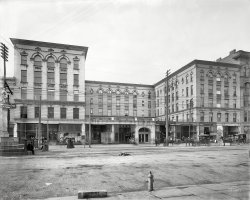
- Sad Cafe: 1908
- ... New York, circa 1908. "The cafe, Fort William Henry Hotel." Welcome to the Purgatory Room, with cocktails and dancing nightly in ... moment The cardinal rule of Fort William Henry Hotel Cafe waiters appears to be "When waiting for customers, waiters must ... Posted by Dave - 08/21/2012 - 1:22pm -
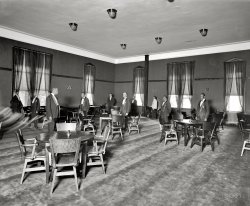
- Topinabee Landing: 1910
- ... wearing back then!
Lunch is Served - at the Topinabee Hotel According to this source your trip started in Petoskey at 9:25 AM ... Topinabee (one hour lunch/dinner stop at the Topinabee Hotel Landing), Dodge’s Point/Club House, Hackmatac Inn and Cheboygan. (This ... Posted by Dave - 10/15/2014 - 5:35am -
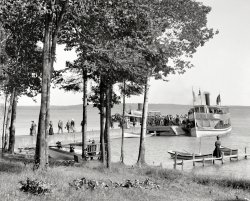
- Manhattan Rising: 1907
- ... Row building and Brooklyn Bridge. View full size.
Hotel Margaret The two pics were taken from the Hotel Margaret, on the NE corner of Orange and Columbia Hts (40.6997N ... Posted by Dave - 12/03/2012 - 10:12am -
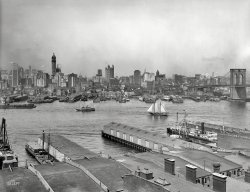
- Eats, Liquors: 1943
- ... and then a very circuitous route Eastward.
Escalante Hotel nearby Off-camera (behind Delano, to the right) is one of the more notable Harvey House hotel/restaurant/depot complexes. Named the Escalante Hotel, it was constructed ... Posted by Dave - 03/01/2014 - 10:57am -
![Eats, Liquors: 1943 March 1943. "Ash Fork, Arizona. Pulling into the Atchison, Topeka & Santa Fe railyard." With much helpful signage. Photo by Jack Delano. View full size.
+71Here's the Liquors building, albeit from a different angle. The well-camouflaged windowless brick building beyond the EATS sign still exists, as well. There is an encouraging amount of tree growth in the last seven decades, making it hard to see which humble bungalows survive.
View Larger Map
Long climb to WilliamsLooking east toward Bill Williams Mountain, and a little beyond that, the Navajo Army Depot, about a 2,000 foot climb from Ash Fork. The Depot was the prime holding area for munitions heading to the Pacific Theater until it was moved to Nevada later in the War.
Ash Fork is known as a flagstone producing and shipping center and its population of 400 is still holding on. The little town that could.
Why?This photo reminded me of a question from my youth (1950s) that nobody ever answered. Why do/did boxcars have those horizontal ridges on the ends? Were they to allow shelving? Were they an artifact of manufacturing? Or were they "just there"? Inquiring minds, etc.....
Those hills in the distanceare two miles away to the East, the tracks make a swing to the North and then a very circuitous route Eastward.
Escalante Hotel nearbyOff-camera (behind Delano, to the right) is one of the more notable Harvey House hotel/restaurant/depot complexes. Named the Escalante Hotel, it was constructed in 1907, and demolished in 1951. Only the boiler smokestack remains. Also to the right is the path of Route 66 through downtown Ash Fork.
Grainy - 35mm ?This photo is unlike any other Jack Delano photograph I have seen. Could this have been a "grab shot" with a 35mm camera?
[It's from a 2-1/4 square roll film negative, but presented here in greater magnification than many other Delano images shot in that format: 2700 pixels wide vs. 1900 for Women Wipers, for example. -tterrace]
[Or you can think of it as less reduced. The full-resolution image is 4252 pixels wide. - Dave]
Gulp & BlowIt looks like the 'Eats' shed and the 'Liquors' sign are strictly for the Railroad men - doesn't seem to be any access road around.
Another great Jack Delano railroad photoNote the collection of sand next to the standpipe on the adjoining rails. Obviously, steam engines with a train in tow would pull up and stop here for water. In order to get going again, the engineer would have to apply sand to the rails to overcome the inertia of getting his train back in motion. Nothing has changed, diesel locomotives have to carry sand for the same traction purposes too. It's still 'the steel wheel on the steel rail'.
Regarding "Why?"These boxcar ends are all steel stampings designed to hold the roof, walls and floor together. The horizontal corrugations were intended to give the end strength to resist the force of the lading pushing against the end. Without them a shifting load might just deform the end enough to break the rivet joints and tear the end out of the car.
These patterns all have names to the students of railroad freightcars. These ends on Illinois Central 28465(?) are pretty standard dreadnaught ends (as opposed to improved dreadnaught ends), probably built by Standard Railway Supply. They were a two part end, with the upper and lower halves joined by a rivet strip between them. If you look at the gap just below the tack board on the right (used to tack messages regarding car destination or handling en route), you can pick out the riveted joint.
(The Gallery, Jack Delano, Railroads)](https://www.shorpy.com/files/images/SHORPY_8d27380u1.thumbnail.jpg)
- Intersection in Southern California
- ... back end of St. Paul's Episcopal Cathedral.
Palomar Hotel Building in the background was The Palomar Hotel. I read somewhere that Charles Lindbergh stayed there. Below is a ... Posted by brianvnt90 - 11/30/2011 - 1:09pm -

- The Tower: 1937
- ... visible. Click to enlarge.
The Chateau Hotel The address is 1001 Chartres Street. I stay there every year when I visit New Orleans. Amazing hotel right in the heart of the Quarter. I've stayed in the rooms to the left ... Posted by Dave - 08/30/2012 - 11:04am -
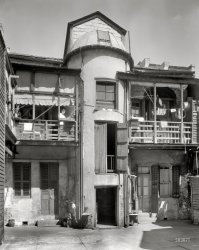
- Deadville: 1939
- ... the Farm Security Administration. View full size.
Hotel de Paris on the left This is Sixth Street looking west. Things are ... what you see here.
The building on the left is the Hotel de Paris. The lion above the gate is still there. On the other side of ... Posted by Dave - 08/14/2020 - 1:59pm -
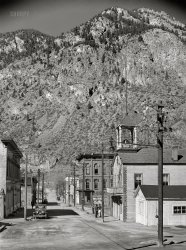
- The Cumberland: 1906
- 1906. "Margaret Street north from Cumberland Hotel, Plattsburgh, N.Y." 8x10 inch dry plate glass negative, Detroit Publishing Company. View full size.
Another Hotel Up In Smoke It lasted until 1978. Then it burned. As seems to happen ... Posted by Dave - 04/17/2019 - 11:23am -
![The Cumberland: 1906 1906. "Margaret Street north from Cumberland Hotel, Plattsburgh, N.Y." 8x10 inch dry plate glass negative, Detroit Publishing Company. View full size.
Another Hotel Up In SmokeIt lasted until 1978. Then it burned. As seems to happen with a lot of old hotels that Shorpy spotlights. Do we have a firebug armed with a time machine that reads this site?
Good old Plattsburg!Looks so peaceful and quaint. Then I looked up a copy of the Plattsburg Republican from June of 1906 --
SignageHere are the two sidewalk signs, de-skewed and contrast enhanced. The sign on the right is likely "Clinton County Fair". Not sure what words are above it, though.
[EVERYBODY GOES. - Dave]
Pull up a chairThis is one of those scenes I'd like to step into. Take a chair on the veranda and watch the trolley go by.
Uncle Pervy and his evil twinI've been accused of believing there's a bolshevik under every bed, but honestly, to my eye that pair of dudes (who look like identical twins), from their vantage point on the Cumberland's veranda, are positively leering at Baby Jane on the sidewalk.
Where's Burghy?I'm an alumnus of the State University of New York at Plattsburgh. I've stumbled -- er, strolled -- down Margaret Street many, many times.
And "Burghy" is the school mascot.
https://blog.suny.edu/wp-content/mascotmadness2014/MM14-Plattsburgh.html
(The Gallery, DPC, Small Towns, Streetcars)](https://www.shorpy.com/files/images/SHORPY-4a18039a.thumbnail.jpg)
- Grand Hotels: 1942
- ... remains. Built as office space in 1910, now a high end hotel. https://www.colcordhotel.com/about Next is the Warner Theater ... building in the State. Just beyond that is the Black Hotel and the Union Bus Station. Both survived until about ten years ago.
... Posted by Dave - 01/15/2024 - 12:00pm -
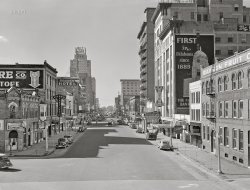
- Dearborn Street: 1907
- ... Chicago." With the base of the massive Great Northern Hotel at right. 8x10 inch glass negative by Hans Behm. View full size.
... to the sign on this wagon. -tterrace]
Great Northern Hotel Here's a Shorpy photo taken four stories further up and ten years ... Posted by Dave - 07/08/2015 - 12:00pm -
![Dearborn Street: 1907 1907. "Dearborn Street, Chicago." With the base of the massive Great Northern Hotel at right. 8x10 inch glass negative by Hans Behm. View full size.
Architectural giants in extreme foreshorteningOn the left-hand (west) side of Dearborn Street we can see (from left to right) slivers of the Monadnock Block (Burnham & Root, 1889-1891), the Federal Building (Henry Ives Cobb, 1905, now demolished), and the Marquette Building (Holabird & Roche, 1893-1895). The buildings shown here on the east side of Dearborn are all long gone.
Far SlotThe cable car slot in the far track that goes around the Loop hasn't been used since 1906.
High WheelerI think the vehicle is a Holsman High-Wheeler. High wheeler cars were really made as rural vehicles, able to cope with high centers and ridiculous amounts of mud; the one in the picture, though, looks to have never been on the wrong end of a cow.
Looking northThis is looking north from Adams and Dearborn. I work around here - previous comments are accurate - the buildings on the east side of this photo are long gone. Monadnock is thankfully still here, and the Marquette, while a neat building, isn't as cool as the Monadnock (in my opinion).
+100Below is the same view from April of 2007.
Paddy wagon?Could that be the tail end of a paddy wagon sticking out from the side street by the Federal Building?
[I think those are the last two letters of U.S. MAIL. similar to the sign on this wagon. -tterrace]
Great Northern HotelHere's a Shorpy photo taken four stories further up and ten years further back.
Thanks...to Bruce Lancaster for identifying the vehicle: my wife and I couldn't figure out what we were looking at. Although my wife did insist it was a car of some sort.
(The Gallery, Chicago, DPC, Stores & Markets, Streetcars)](https://www.shorpy.com/files/images/SHORPY-4a22365a.thumbnail.jpg)
- Cameron Hill: 1864
- ... up there, dominating the downtown.
READ HOUSE HOTEL BRICK BUILING IN LEFT SIDE OF PICTURE IS THE READ HOUSE HOTEL. WHICH STILL IN BUSINESS IN THIS SAME LOCATION. IT'S IN A NEWER BUILDING ... Posted by Dave - 10/18/2008 - 5:57pm -
![Cameron Hill: 1864 1864. "Chattanooga, Tennessee. Adams Express office and the Crutchfield house with Cameron Hill in the distance." Photographer unknown. View full size.
Now an insurance companyCameron Hill still dominates downtown Chattanooga, but because of today's buildings it's impossible to duplicate this view, which is generally from the southeast looking northwest. The hill is also thick with trees on the northeast and east sides but the top overlooks the Tennessee River. Until a few years ago the top was residential but now an insurance company is building its headquarters up there, dominating the downtown.
READ HOUSE HOTELBRICK BUILING IN LEFT SIDE OF PICTURE IS THE READ HOUSE HOTEL. WHICH STILL IN BUSINESS IN THIS SAME LOCATION. IT'S IN A NEWER BUILDING OF COURSE. MOST OF THE TOP OF CAMERON HILL WAS USED AS FILL FOR A DOWNTOWN FREEWAY,IN THE 1960S.
NOW THE HUGE INSURANCE CO.
[MANY THANKS FOR TELEGRAM - STOP - MIGHT WANT TO CHECK THAT CAPS LOCK KEY - STOP - DAVE]
(The Gallery, Civil War, Railroads)](https://www.shorpy.com/files/images/02124u.thumbnail.jpg)
- 30 Rock: 1933
- ...
Other noteworthy background details here include the Hotel Edison, and the old NY Times Building, at Times Square, before they went ... to it, with the illuminated sign on top, is the New Yorker Hotel (now Sun Myung Moon's) where Nikola Tesla spent the last ten years of his ... Posted by Dave - 07/17/2012 - 10:22pm -
![30 Rock: 1933 New York. December 5, 1933. "Rockefeller Center and RCA Building from 515 Madison Avenue." Digital image recovered from released emulsion layer of the original 5x7 acetate negative. Gottscho-Schleisner photo. View full size.
City of the godsIn 1933, my father was a seven-year-old living up Lick Branch Hollow in the Ozark Mountains. He would read books by kerosene light in the evenings. His family kept butter and milk (and Uncle Linus' hooch) in the cold spring-fed creek outside their house. It's astonishing to think he could have boarded a train and eventually arrived in this city of the gods, only a thousand miles away.
Sign of the CrossThe double bar cross was the emblem used by the National Tuberculosis Association. Wonder if the lights were part of the campaign to fight TB.
Gotta love those whitewalls!On the convertible by the front door. Double O's. Looks like it's ready to go somewhere in a hurry.
Released emulsion layer?Dave, can you explain the technology of this image? How does an emulsion layer get released from a negative?
[This is a process used on deteriorating acetate transparencies and negatives when they've begun to shrink. The negative is placed in a chemical solution that separates the emulsion from the film base. The released emulsion layer (the pellicle) is then placed in another solution to "relax," or unwarp, it. It's kind of like disappearing your body so that only the skin is left. More here. - Dave]
Amazing viewThe shot is incredible! It looks almost surreal. I love it!
Awesome scan job.I only wish I could see an even higher res version. Great work bringing this one back to life.
WowI just can't believe how beautiful this shot is. Looks like the view from my New York Penthouse sitting there drinking martinis and listening to that new "jazz" music.
High DramaThis marvelous building, reaching for the sky as if erupting from the ground, combines amazing delicacy, impressive size, and a feeling it is built for the ages to admire. SO much more breathtaking than today's typical glass box, although you need a view like this to really appreciate the classical lines and artful massing. A nice complement to the gothic cathedral in the foreground - a true temple of commerce!
Churchly And Corporate SpiresThat's St. Patrick's Cathedral on the lower left, probably the only building from the 19th century left on Fifth Avenue, except for the Chancery House that's attached to it.
Both styles of architecture are very dramatic. When I was a small child, at Christmas, my family would go to the Christmas Pageant at Radio City Music Hall every year, and then attend Midnight Mass at St. Patrick's.
Ever since, I've never been able to separate religion from showbiz. Possibly because they really are the same thing.
Take a peekThis picture makes me want to get out the binoculars and look in the windows.
"Don't get much better"This image is a about as close to textbook perfect BW as you will find. It contains the complete range of grays from what looks like solid black in a few places to solid white in the highlights. The camera was level and the focus was dead on. As a photographer, I am envious.
Old shooter
Reaching New HeightsThe skyscraper is 30 Rockefeller Plaza before the RCA and current GE neon signage. Not that it wasn't famous before, but the TV show "30 Rock" has made it an even more iconic. Another claim is the gigantic Christmas tree on the Plaza, between the building and the skating rink, that when illuminated kicks off the Holiday Season in NYC.
Hugh FerrissThis is like the photographic equivalent of one of Hugh Ferriss' architectural drawings, coincidentally of roughly the same era.
MagicThe quality of this incredible photo captures the magic that New York City always longs for but seldom delivers.
King Kong might have had a chance...had he chosen 30 Rock instead.
OKLo mismo digo.
Gracias.
American Express BuildingThat hole in the ground, I believe, bacame the American Express Building. If you come out of the subway at the Rockefeller Center stop, and come up on the escalator in that building, you get an incredible view of St Pat's from below, with the spectacular statue of Atlas in the foreground as well. Very cool.
Other noteworthy background details here include the Hotel Edison, and the old NY Times Building, at Times Square, before they went and utterly ruined it in the 60's by stripping all the detail off the skeleton.
And check the skylights on the roof of what I think is the Cartier store, in the foreground!
Send this to Christopher NolanHere's the art direction for the next Batman sequel.
SpectacularWhat a wonderful, wonderful image! I love coming to Shorpy because you never know what Dave will come up with next.
Thanks so much!
The GreatestDave, this has to be one of the greatest photos you have posted. I work around the corner, and can look out my window at 30 Rock from 6th Avenue... my building wasn't built until 1973. Thank you.
Time stoppedIs it 2:25am or 5:10am?
Can you spot the clock?
What Gets MeLooking at this photo - and it looks spectacular on my new monitor - is the sky. It has a sort of foggy twilight quality that is difficult to put into words but which emphasizes the the "star" of the photo - the RCA Building - and its nearby consorts or supporting cast over the buildings in the background which seem to fad into the mist.
The building seems like the height of modernity, and one can easily imagine a couple of kids from Cleveland named Siegel and Shuster seeing this and making it a model for the cities of the doomed planet Krypton.
Very neat picture...Can you give us an idea of what it looked like before it was restored?
[There's an example here. - Dave]
StunnedWhat a totally wonderful image, Sat here slack jawed at the incredible detail and the superb composition.
I am amazedThe detail in the spires at St. Paul's Patrick's is fantastic. The amount of work that went into that building must have been enormous. I am very grateful not to have been on the crew detailed to put the crosses atop the spires!
The Future Is NowInteresting that this photograph looks into a future in which many of the same buildings are still with us. At far left midground is the tower of Raymond Hood's American Standard Building. Next to it, with the illuminated sign on top, is the New Yorker Hotel (now Sun Myung Moon's) where Nikola Tesla spent the last ten years of his life. At center is the N.Y. Times Building with its flagpole convenient for deploying the New Year's Eve ball. And last, but not least, the Paramount Building topped by a globe and illuminated clock which is about as close to the Hudsucker Building as could hope to be seen. Of these four only the appearance Times Building has changed to any extent. A wonderful slice of time.
TremendousTwo of my favorite photos on Shorpy consist of those like this one, showing the immense power of a huge city, even in the depths of the Depression, and those of small towns, especially when patriotic holidays were still celebrated.
Samuel H. GottschoI'd never heard of him, but one look at this photo and I'm instantly a fan. This image is nothing short of spectacular.
Ethereal, PowerfulThere have been many photos on this site that have impressed and pleased me, but this one is one of my favorites. Absolute magic. It's the quintessence of the power and style of 1930s design.
Time machineI admire NY photos of the 1950s. And now I see that many of the buildings in NY I admire already were erected in early 1930s! What a discovery. What a shot.
The Singularity of the MomentThis is an amazing photograph.
As one earlier contributor observed, the pure technical aspects of the black and white composition are fabulous. The spread of detailed gray shadows and whites make this photo almost magical. It has the qualities of an Ansel Adams zone photograph that makes his work so arresting.
But what really makes this photograph dramatic is what it reveals about New York City in 1933.
A vision of the future of large cities, bustling twenty four hours a day and electrified. Today visions such as these can be seen on any continent in any large city. It has become the norm. But in 1933 there were only two places in the world that looked like this: New York City and Chicago.
One can vicariously put oneself into the shoes of some kid from rural America or from Europe setting on Manhattan Island and seeing visions such as these for the first time. I can only guess it had the same effect as it had on 14th-century peasants in France, visiting Paris for the first time and entering the nave of the Notre Dame Cathedral.
Beautifully put!I'm sure Samuel Gottscho would have been very gratified to know thoughtful and eloquent people like Bob H would be appreciating his work in the 21st century.
PenthouseIs the Garden Patio still across the street from the skylights?
I am in love with this photographExquisite doesn't even begin to describe it.
In Your Mind's EyeYou can smell and feel the air and hear the traffic.
It may be calm now...I have a feeling that all hell is about to break loose -- this picture was taken the day Prohibition was repealed.
I worked hereI worked here in the 1960s for the "Tonight" show unit as as a production assistant for Dick Carson, brother of Johnny Carson. An attractive, dark-haired woman named Barbara Walters was working at the "Today" show at the same time. She is about 10 years older than I am.
I also worked with the News department for a time. I was in the elevator with David Brinkley coming back from lunch when I learned that President Kennedy had been shot. We stayed up all Friday night and most of Saturday assembling film footage for a retrospective of JFK's life. When we weren't editing, we were visiting St. Patrick's Cathedral to light candles with others in the crowd.
That's an absolutely amazing photo. I'm going to link this to other New Yorkers and broadcasters who might be interested.
Thanks for all your work.
Cordially,
Ellen Kimball
Portland, OR
http://ellenkimball.blogspot.com
30 RockIs the excavated area where the skating rink is? I've been there once and it is very magical. Right across the street from the "Today" studio.
Tipster's PhotoStunning, but in a different way than Gottscho's. It helps when the subject is beautiful.
30 Rock 09
Here's the view today made with a 4x5 view camera, farther back seen through the St. Patrick's spires and somewhat higher than the 1933 photo. Lots more buildings now. I was doing an interior architectural shoot, and went out on the terrace of a wedding-cake building on Madison Avenue. It was after midnight. Not much wind. Strangely quiet.
As an architectural photographer I have great admiration for these Gottscho pictures.
30 Rock in Living ColorThat's a lovely photo, and it's nice to see the perspective so close to that of the original.
Design Continuum of Bertram GoodhueThe proximity of St. Patrick's Cathedral to the newly constructed tower by Raymond Hood brought to mind two "bookends" to the unfulfilled career of Bertram Goodhue. During his early apprenticeship he undoubtedly worked on the St. Patrick's Cathedral, in Renwick's office, which greatly influenced his early career and success. The tower (30 Roc) represents what might have been...rather what should have been the end result of Goodhue's tragically shortened career (ending in 1924). Hood's career, which began to emerge after Goodhue's death is far better known, but is greatly in his debt. Hood's 1922 Tribune Tower clearly displays this link, as a practitioner of the neo-gothic style. Much of Hood's gothic detail is a through-back to design ideas that by 1922, Goodhue had already left behind.
Goodhue was by this time already synthesizing elements of european modernism into an new original american idiom. Goodhue's last major projects were already working out the language of the modern/deco skyscraper; (the Nebraska State capital and Los Angles Public Library the best examples.) Goodhue's unique career was the crucible where concepts of romantic imagery of the Gothic, the sublime juxtapositions of minimal ornament on architectonic massing was being forged with modern construction technology. A close study of his career and work will show that not only Hood, but other notable architects of the era built upon the rigorous and expansive explorations that Goodhue was beginning to fuse at the end of his life.
*It is also curious to me that Hugh Ferris is credited with so much of these innovative design ideas; no doubt he was a super talented delineator, his freelance services were utilized by many architects of the time including Goodhue. Some of his famous massing studies (sketches) owe much to Goodhue's late work.
Amazing Execution and RestorationI agree with "Don't get much Better" ! This is as good as it can get for B&W. The exposure is so right-on and this in 1933!! Is this a "night" shot.. there is a lot of ambient light. Simply Amazing. I want it!
Rock RinkThe not-yet-built skating rink is in front of the building. The empty space became 630 Fifth Avenue, where a statue of Atlas stands.
Vanderbilt Triple PalaceA long time since this was posted, but I am surprised no one recognized the southern half of the iconic, brownstone-clad Vanderbilt Triple Palaces in the foreground (640 Fifth Avenue), just opposite the lower edge of the excavated building site.
The northern half, with two residences, had been sold, demolished & replaced a long time ago, but the southern half stood until 1947 (Grace Wilson Vanderbilt continued entertaining in her usual style until WWII).
The entrance vestibule to the three residences featured a nine foot tall Russian malachite vase, once given by Emperor Nicholas I of Russia to Nicholas Demidoff, now on display at the Metropolitan Museum of Art a couple of dozen blocks north on Fifth.
(The Gallery, Gottscho-Schleisner, NYC)](https://www.shorpy.com/files/images/05853u1.thumbnail.jpg)
- The Northern: 1907
- Littleton, New Hampshire, circa 1907. "Northern Hotel and post office block." 8x10 inch dry plate glass negative, Detroit ... Larger Map
An N Model N Ford in the middle.
Hotel Burned down in 1924. Looks almost brand new in the photo.
(The ... Posted by Dave - 05/06/2013 - 1:47pm -
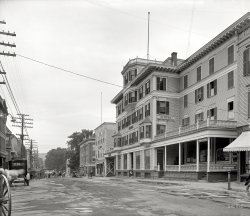
- Easier Living: 1951
- ... nearest pizza joint.
Yoo-hoo Rob? Laura?
Not a Hotel Room Wanamaker's was a chain of department stores. I assume even ... Posted by Dave - 12/26/2013 - 5:30pm -
![Easier Living: 1951 October 12, 1951. Great Neck, Long Island, N.Y. "Statton Modern at John Wanamaker. Russel Wright bedroom group. Auerbach Agency, client." Large-format acetate negative by Gottscho-Schleisner. View full size.
Travelodge, Version 1.0B Tests of this Beta version indicated strong user demand for matching, floral-print bedspreads and curtains.
Left bed is widerI count four and a half squares of bedspread/comforter crossing the left bed and barely four squares on the right one. How's that for precise measurement?
Peaceable KingdomRousseau's 'Peaceable Kingdom' seems an odd choice of artwork for the wall of such a modern, trendy room. AND it's such a small print, too. It happens to be a favorite of mine, but I would have thought something more contemporary would have been the preferred choice for a model room. But who knows what Wanamaker's decorator had in mind?
Next ExitThis example of a room will be the prime design of all the forthcoming motel rooms in North America.
All that's missing1. A USB charging port built into the base of the lamp.
2. An antimicrobial-coated remote control.
3. A table card with the Wi-fi instructions, and another with the phone number of the nearest pizza joint.
Yoo-hooRob? Laura?
Not a Hotel RoomWanamaker's was a chain of department stores. I assume even though it looks like it could be any 50's motel it is a model bedroom on a sales floor.
War on men"Hers" and "his" beds?
His and Hers?It looks to me that the left side is about a foot wider than the right side.
Optical illusion?Doesn't the left twin bed look wider than the right?
That saidWhy does the headboard fit the two mattresses perfectly? Was this a precursor to the king? I still don't understand the California king but I'm from the south.
ChintzyGenerally I love Russel Wright's ideas. Most everything in this room is appealing. But the chintz finish on the bedspreads is everything people criticize about mid-cent decor. It looks cold and stiff.
Horny?Not only is that piece of art out of scale, it is also terribly off-centered. My question is , is it suposed to be symbolic of the person sleeping below it? Horny
["The Peaceable Kingdom" by Edward Hicks. -tterrace]
(The Gallery, Gottscho-Schleisner, Stores & Markets)](https://www.shorpy.com/files/images/SHORPY_5a17221u.thumbnail.jpg)
- A Dickey Christmas: 1919
- ... in DC. Divorced, he was living at the Stonewall Jackson Hotel in Clarksburg, West Virginia. I did not find anyone who might be John in ... Posted by Dave - 12/20/2023 - 3:27pm -
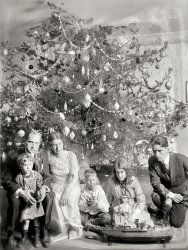
- Grand Entrance: 1952
- ... nearly half of the market in those years.
My honeymoon hotel The Mark - where I spent my first night of my honeymoon only 2 years ... back then was an extraordinary amount of $ to spend on a hotel room! We stayed there 1 more time later and they had put in grass on the ... Posted by Dave - 07/05/2016 - 9:57pm -
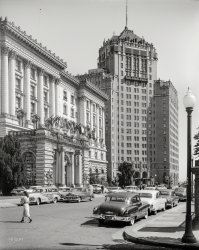
- AC: 1900
- ... [Funny -- they built the pier that way, too. - Dave]
Hotel Pierrepont The $50,000 lobby. From an old postcard.
Progress I ... Posted by Dave - 08/02/2012 - 3:17pm -
![AC: 1900 The Jersey Shore circa 1900. "Atlantic City from lighthouse." View just to the left of the previous post. Detroit Publishing Company glass negative. View full size.
Looks much better than todayI went for the first time a couple years ago, I would have rather had a time machine and gone back to 1900. That place is like a sewer now, I wouldn't go back even if you paid for everything.
Pretty neat old buildings here, though. What do you think they offer at the Capitol Sample Room?
GloomyThis photo reminds me of the first lines of Don Henley's song "Boys of Summer":
Nobody on the road,
Nobody on the beach.
I feel it in the air,
Summer's out of reach.
It would be interesting if some of the same shots were taken from the lighthouse during a warm afternoon on a summer weekend.
In the WaterThey seemed to have placed the utility poles below the tide line. Is that the way it was done elsewhere?
[Funny -- they built the pier that way, too. - Dave]
Hotel PierrepontThe $50,000 lobby. From an old postcard.
ProgressI don't know about the Jersey Shore being like a "sewer" but it certainly is an overbuilt nightmare now. People are living (or staying) on top of each other. This is a vacation? Not only the shore, but the people as well are very different now than in 1900.
(The Gallery, Atlantic City, DPC)](https://www.shorpy.com/files/images/4a05143a.thumbnail.jpg)
- F.A.B.: 1910
- ... it in April this year.
Site of the Fifth Avenue Hotel This handsome Beaux-Arts building replaced the once fashionable Fifth Avenue Hotel, which opened on this site in 1859 and closed its doors in 1908. This ... Posted by Dave - 09/16/2012 - 1:34pm -
